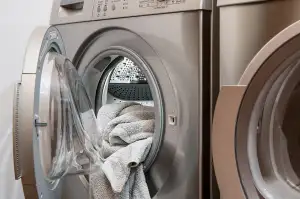Say Goodbye to Grease Stains: Expert Tips for Removing Grease from Clothes at Home

- Preparing the stained garment for treatment
- Applying dish soap to the grease stain
- Gently scrubbing the stain with a soft brush or cloth
- Soaking the garment in warm water and laundry detergent
- Washing the garment in the washing machine
- Checking the stain after washing and repeating the process if necessary
- Drying the garment according to fabric instructions
- Additional tips and precautions for removing grease stains at home
Grease stains on clothes can be a real headache, but with the right techniques and products, you can say goodbye to those stubborn marks. Whether it's cooking oil, butter, or motor oil, these greasy stains can ruin your favorite garments if not treated properly. In this article, we will guide you through expert tips for removing grease stains from clothes at home. So roll up your sleeves and get ready to bid farewell to those pesky grease stains once and for all!
Preparing the stained garment for treatment
Before treating a grease stain on your clothes, it is important to prepare the stained garment properly. Start by removing any excess grease or oil from the fabric. You can do this by gently blotting the stain with a clean paper towel or cloth. Be careful not to rub the stain, as this can spread it further and make it more difficult to remove. If the stain has already dried, you can use a dull knife or spoon to scrape off any hardened residue. Once you have removed as much of the excess grease as possible, turn the garment inside out and place it on a clean surface. This will allow you to work directly on the stain without causing any damage to the fabric.
Applying dish soap to the grease stain
Applying dish soap to the grease stain is a crucial step in removing it effectively. Dish soap contains powerful degreasing agents that can break down and lift the grease from the fabric. Start by applying a small amount of dish soap directly onto the stain. Gently massage it into the fabric, ensuring that the soap covers the entire stained area. Allow the dish soap to sit on the stain for at least 5-10 minutes to penetrate and loosen the grease. This will enhance its effectiveness when it comes time to scrub and remove the stain.
Gently scrubbing the stain with a soft brush or cloth
Once you have applied the dish soap to the grease stain, it's time to gently scrub the area. Use a soft brush or cloth and work in circular motions to loosen the grease from the fabric fibers. Be careful not to rub too vigorously, as this could damage the fabric. Take your time and continue scrubbing until you see the stain starting to fade. Remember, patience is key when it comes to removing grease stains from clothes.
Soaking the garment in warm water and laundry detergent
To further tackle the stubborn grease stain, soak the garment in a mixture of warm water and laundry detergent. Fill a basin or sink with enough warm water to fully submerge the stained area. Add a generous amount of laundry detergent to create a soapy solution. Gently agitate the water to ensure the detergent is evenly distributed. Place the garment in the soapy water, making sure the stain is completely submerged. Allow it to soak for at least 30 minutes, or longer for tougher stains. The warm water and detergent will work together to break down and loosen the grease particles from the fabric fibers, making them easier to remove during washing.
Washing the garment in the washing machine
Once you have treated the grease stain on your garment, it's time to wash it in the washing machine. Before doing so, check the fabric care instructions to ensure that the garment is suitable for machine washing.
Turn the garment inside out to protect the outer surface during the wash cycle. Place it in the machine along with other similar items, taking care not to overload the machine.
Select a gentle or delicate cycle and use cold water. Avoid using hot water as it can set the grease stain further into the fabric. Add an appropriate amount of laundry detergent according to the manufacturer's instructions.
Allow the washing machine to complete its cycle, ensuring that all traces of grease are removed from your garment. Once finished, carefully remove the garment from the machine and inspect it for any remaining stains.
If there are still visible grease stains, repeat the treatment process before attempting another wash cycle. It may take multiple attempts to completely eliminate stubborn grease stains.
Remember to always follow any specific instructions provided by your clothing manufacturer or consult a professional cleaner if you are unsure about treating certain fabrics or materials.
By following these steps and being diligent in your approach, you can effectively remove grease stains from your clothes and restore them back to their original condition.
Checking the stain after washing and repeating the process if necessary
After washing the garment, it is important to check the stain to see if it has been completely removed. If there are still traces of grease, do not panic. Simply repeat the process from step 2 onwards. Pre-treat the stain with dish soap, gently scrub it, soak the garment in warm water and laundry detergent, and wash it again in the washing machine. This may be necessary for stubborn or older grease stains. Remember to always check the fabric care instructions before repeating the process to ensure that it is safe for your garment. Patience and persistence are key when dealing with tough grease stains, so don't give up until you achieve satisfactory results.
Drying the garment according to fabric instructions
Once you have successfully removed the grease stain from your garment, it is important to dry it properly according to the fabric instructions. Different fabrics require different drying methods to prevent any damage or shrinkage.
For garments made of delicate fabrics such as silk or wool, it is best to air dry them by laying them flat on a clean towel or hanging them up using a padded hanger. Avoid wringing or twisting the garment as this can distort its shape.
For sturdier fabrics like cotton or polyester, you can safely tumble dry them on low heat. However, be sure to check the care label first to ensure that tumble drying is recommended for that particular garment.
If the garment is still slightly damp after air drying or tumble drying, you can use an iron on low heat to remove any remaining moisture. Place a clean cloth between the iron and the garment to protect it from direct heat.
Remember, always follow the fabric instructions provided by the manufacturer for best results. Properly drying your freshly cleaned garment will ensure that it maintains its shape and quality, leaving you with clothes free from both grease stains and damage caused by improper drying techniques.
Additional tips and precautions for removing grease stains at home
- Avoid using hot water on grease stains as it can set the stain further into the fabric. Stick to warm or cold water instead.
- Test any stain removal method on a small, inconspicuous area of the garment first to ensure it doesn't cause any damage or color fading.
- For stubborn grease stains, consider using a pre-treatment stain remover before applying dish soap.
- Blotting the stain with a paper towel or cloth before treating it can help remove excess grease and prevent spreading.
- Avoid rubbing or scrubbing too aggressively, as this can push the grease deeper into the fabric fibers.
- If you're dealing with delicate fabrics like silk or wool, it's best to consult a professional cleaner for safe and effective stain removal.
Remember, prompt action is key when it comes to removing grease stains. The sooner you treat the stain, the better chance you have of successfully removing it.
In conclusion, effectively removing grease stains from clothes requires a combination of preparation, treatment, and proper washing techniques. By following the steps outlined in this article, you can say goodbye to those stubborn grease stains and restore your garments to their former glory. Remember to act quickly, as fresh stains are easier to remove. Additionally, always check the fabric care instructions before attempting any stain removal method. With a little patience and the right tools, you can successfully eliminate grease stains and keep your clothes looking clean and fresh.
Published: 20. 12. 2023
Category: Home



